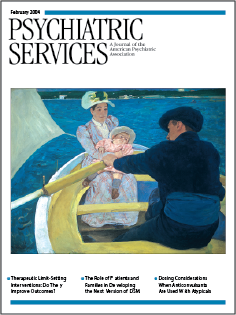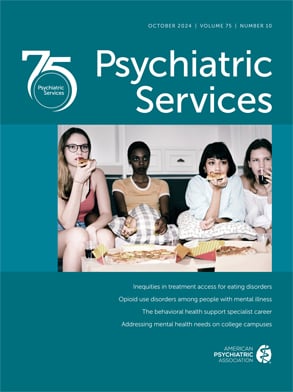Bipolar disorder has a clear economic impact on patients with the disorder, their families, caregivers, and society as a whole. In addition, the prevalence of bipolar disorder may be underestimated, and the treatment is often inappropriate. Inadequate treatment is likely to increase the cost of care, as well as the burden of illness on the individual, families, and caregivers.
The economic impact of bipolar disorder
The onset of bipolar disorder often occurs in what should be a particularly productive time of life. The Epidemiologic Catchment Area study found that the mean ages of onset for bipolar I and II disorders were approximately 18 and 22 years, respectively (
4).
Regardless of age of onset, there is typically a five- to ten-year delay between onset and time of first treatment or first hospitalization (
5). People with bipolar disorder usually see several doctors and, on average, spend more than eight years seeking treatment before receiving a correct diagnosis (
6), which is likely to further influence outcome, as well as account for notable economic impact.
Once bipolar disorder is diagnosed, actual treatment often falls far short of established treatment guidelines. In an evaluation of hospitalized patients with bipolar disorder, only one in six patients discharged were receiving medications that were consistent with national treatment guidelines (
7). In a recent study of outpatients with bipolar disorder, more than one-third of the patients were not receiving any mood stabilizers (
8). An analysis of 3,349 patients with bipolar disorder in California's Medicaid (Medi-Cal) program from 1994 to 1998 found that 58 percent never received a mood stabilizer in the year following their diagnosis of bipolar disorder. Direct health care costs were significantly higher among patients who delayed taking or who did not use mood-stabilizing agents during the first year of their diagnosis (
9).
The economic burden of bipolar disorder in the United States is substantial. Using a lifetime cost simulation model, Begley and colleagues (
10) determined that the lifetime cost for persons with bipolar disorder was $24 billion in 1998, whereas Wyatt and Henter (
11) calculated a cost of $45 billion in a 1991 sample. Unlike cost studies that determine the annual cost for prevalent cases, the lifetime estimate cost model by Begley and colleagues for incident cases is appropriate for evaluating potential cost savings from a reduction in the disease incidence rate or an improvement in the long-term disease maintenance. In the study by Begley and colleagues, average lifetime cost per case ranged from $11,720 for persons with a single manic episode to $624,785 for persons with nonresponsive or chronic episodes. In the Wyatt and Henter study, direct costs totaling $7 billion consisted of expenditures for treatment-related inpatient and outpatient care, as well as non-treatment-related costs, such as use of the criminal justice system. The $38 billion in indirect costs from the Wyatt and Henter study included the lost productivity of wage earners, totaling $17 billion; homemakers, $3 billion; and caregivers, $6 billion, as well as the cost of institutionalization, $3 billion, and the lost productivity costs for individuals lost to suicide, $8 billion.
Providing close daily contact and care to patients with bipolar disorder exacts a toll on their families and caregivers. Many patients with bipolar disorder divorce or experience marital problems. Not only must caregivers of patients with bipolar disorder deal with the impact of patients' symptoms, caregivers also feel the effects of patients' illness on their work and leisure time. The combination of missed work hours and lower productivity caused by stress adds a financial burden on the caregiver, as well as on society as a whole.
Bipolar disorder is the sixth leading cause of disability worldwide (
12). Patients with bipolar disorder and their families experience significant losses in functional status and quality of life, placing untoward stress on personal relationships. Loss of employment, difficulty in regaining employment, days lost from work, and the potential for increased interactions with the criminal justice system all contribute not only to the cost but also to the disability associated with bipolar disorder.
In a literature review on functional impairment and cognition in bipolar disorder, Zarate and colleagues (
2) found that the majority of patients with bipolar disorder experienced a limited functional recovery. Although many patients with bipolar disorder show gradual improvement in the first several years after diagnosis, a substantial number of patients still experience poor adjustment in key domains of functioning. The reasons for this are not clear.
The degree of functional impairment may be even greater for patients with bipolar disorder and comorbid personality disorders. Such patients are at greater risk for intrapsychic and psychosocial stress, which may precipitate or exacerbate mood swings. In addition, these patients typically have greater symptom burden and lower recovery rates (
13).
Patients with bipolar disorder and comorbid substance abuse place additional stresses on the health care system, because they commonly experience fewer remissions and poorer outcomes than non-substance abusers. Bipolar disorder with comorbid substance abuse is also associated with higher rates of refractoriness to lithium treatment (
14) and higher risks of suicide attempts and completions (
13).
Data from the Epidemiologic Catchment Area study (
15) demonstrated that substance abuse or dependence is more frequently diagnosed among persons with bipolar disorder than among persons with any other axis I disorder. The study found that approximately 56 percent of patients with bipolar I and II disorder abused or were dependent on drugs, and approximately 44 percent had comorbid alcohol abuse. Lifetime prevalence rates of substance abuse among persons with bipolar I disorder are more than three times those seen in the general population, whereas patients with bipolar II are more than twice as likely to abuse substances than patients with unipolar depression. Earlier recognition and treatment of bipolar disorders in children and adolescents could reduce the risk of subsequent substance abuse.
Patients with bipolar disorder frequently suffer from a range of comorbid psychiatric disorders aside from substance abuse, including personality disorders, anxiety disorders, eating disorders, and attention-deficit hyperactivity disorder. Bipolar disorder is also associated with a range of serious comorbid medical conditions, including obesity, diabetes mellitus, migraine, and multiple sclerosis. The mortality rate for untreated bipolar disorder is higher than that of the general population and is higher than that seen in most other psychiatric disorders (
16).
Conclusions
Bipolar disorder clearly has far-reaching economic consequences for the individual, families, caregivers, and society as a whole. There is increasing awareness that prevalence rates are likely to be higher than previously believed and that the impact of bipolar disorder may be far greater than envisaged in the past. Increased precision in diagnosing bipolar disorder is needed, as well as increased attention to ensuring that the treatment that is initiated and continued is consistent with established treatment guidelines.
The ramifications of bipolar disorder include a significant economic toll, as well as family disruption, caregiver stress, and an individual burden encompassing comorbid illnesses, substance abuse, poor functionality, and high suicide risk. Studies have found that years elapse before patients are correctly diagnosed, and inadequate treatment is likely to increase the illness burden and cost of care. Under these circumstances, clinicians are obligated to be wary of the possible missed diagnosis of bipolar disorder. It is also important that clinicians maintain an awareness of attendant comorbid illnesses and the risk of suicide in these patients. Finally, adequate and individualized treatment is paramount in lessening the burden of illness experienced.

